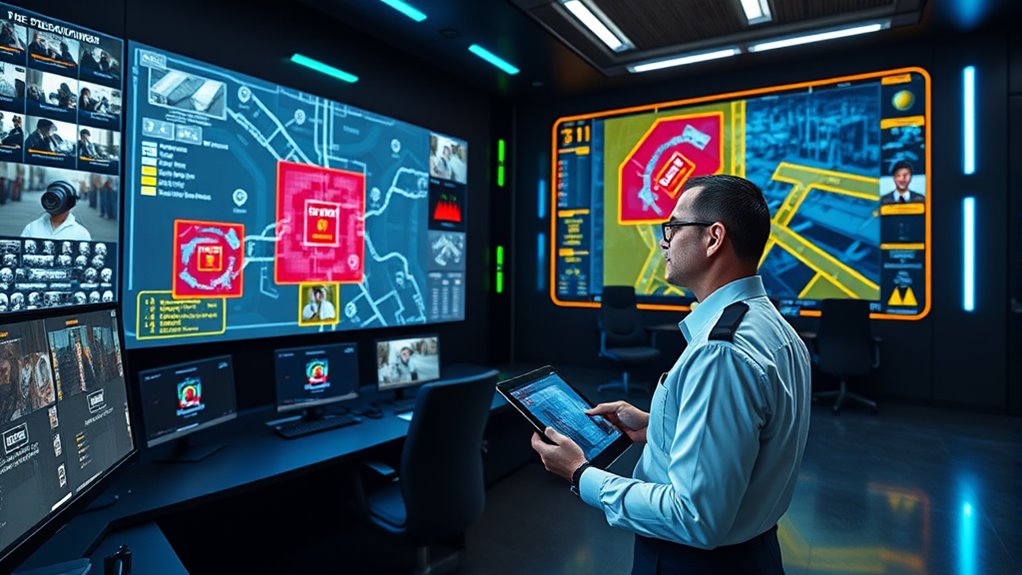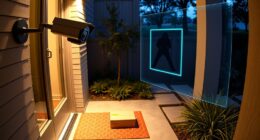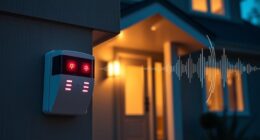To guarantee efficient monitoring and response, you should carefully design alarm zones by dividing your property into distinct areas linked to specific sensors. This helps target threats accurately, reduce false alarms, and speed up response times. Set clear protocols for each zone, like immediate alerts for high-security areas and notifications for perimeter zones. Properly structured zones improve overall security and incident management. Keep exploring to discover how to optimize your alarm zone setup even further.
Key Takeaways
- Segment the property into distinct zones based on risk levels and function for targeted monitoring.
- Assign specific sensors to each zone to enhance detection accuracy and reduce false alarms.
- Develop clear response protocols tailored to each zone’s security requirements and threat levels.
- Regularly review and update zone configurations to adapt to changing security needs and vulnerabilities.
- Incorporate visual and audible alerts linked to zones to facilitate quick identification and response.

Designing effective alarm zones is fundamental for ensuring your security system responds accurately to different threats. When you implement alarm zone segmentation, you create distinct areas within your property, allowing your system to identify where an issue occurs with precision. This segmentation helps prevent false alarms caused by external factors like animals or weather, and it guarantees that genuine intrusions trigger appropriate responses. By carefully dividing your property into zones, you gain better control over monitoring, enabling quicker and more targeted reactions to potential threats. Each zone can be assigned specific sensors and parameters, making your security setup more customized and effective. Additionally, understanding security system terminology can help you better plan and implement your alarm zones effectively.
Once you establish these zones, it’s essential to develop clear zone response protocols. These protocols define how your system reacts when an alarm is triggered in each zone, ensuring a well-coordinated response. For example, if an intrusion is detected in a high-security area like a vault or server room, your protocol might involve immediate alerts to security personnel and lockdown procedures. Conversely, if a peripheral zone such as a backyard is breached, the response might include activating cameras, sounding alarms, and notifying you or security staff. Setting these protocols in advance minimizes confusion and delays, so everyone involved understands their role during an incident. Properly configured zone response protocols also help distinguish between false alarms and real threats, reducing unnecessary panic or costly dispatches.
Frequently Asked Questions
How Do Alarm Zones Adapt to Changing Security Threats?
You adapt alarm zones through dynamic threat adaptation, ensuring your system remains responsive to evolving security risks. By implementing zone flexibility, you can quickly reconfigure or expand zones as new threats emerge or patterns change. This proactive approach allows your monitoring system to stay effective, minimizing false alarms and enhancing safety. Regularly reviewing and updating zone configurations keeps your security measures aligned with current threats, providing ongoing protection.
What Are the Best Practices for Integrating Alarm Zones With Existing Systems?
To integrate alarm zones effectively, you should focus on seamless system integration with your existing security infrastructure. Make certain of compatibility between new alarm zones and current systems, like CCTV or access controls. Additionally, provide user training to familiarize staff with zone functions and response protocols. Regularly test the integrated setup to identify and fix issues promptly, maintaining a reliable security system that adapts to evolving threats.
How Can False Alarms Be Minimized Within Alarm Zones?
You can minimize false alarms by focusing on false alarm reduction through proper zone calibration. Regularly test and adjust alarm zones, ensuring sensors are sensitive enough to detect genuine threats but not triggered by minor disturbances. Use advanced detection algorithms and incorporate multiple sensors for confirmation. Training personnel on correct system use also helps prevent false alarms, making your monitoring more reliable and efficient.
What Role Does Automation Play in Alarm Zone Management?
Automation plays a vital role in alarm zone management by integrating systems for seamless response optimization. You can set up automation integration to quickly identify false alarms, reduce response times, and alert the right personnel. With automation, you streamline monitoring processes, ensuring efficient handling of alarms, minimizing human error, and enhancing overall security. This proactive approach helps maintain a balanced, reliable alarm system that responds swiftly and accurately.
How Are Alarm Zones Customized for Different Types of Facilities?
Facility features fuel focused zones. You customize alarm zones based on facility layout, tailoring alerts to specific zones like entrances, hallways, or sensitive areas. This precision helps security personnel respond swiftly and smartly. By considering facility functions and flow, you create clear, customized zones that optimize monitoring and maximize safety, ensuring security personnel are always alerted to the right risks without unnecessary noise or confusion.
Conclusion
Now that you understand how to design alarm zones effectively, the real challenge begins. Will your setup catch every threat before it’s too late, or will a blind spot slip through unnoticed? Every decision you make could be the difference between swift response and costly delays. Stay vigilant, refine your zones constantly, and never underestimate the power of a well-planned system. The future of your security depends on the zones you create today—are you ready to face what’s next?









